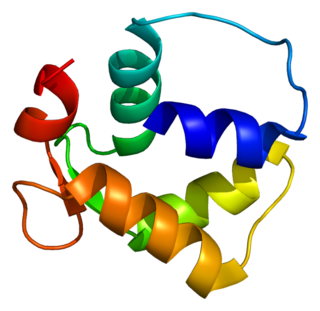
In cell biology, the centrosome is an organelle that serves as the main microtubule organizing center (MTOC) of the animal cell, as well as a regulator of cell-cycle progression. The centrosome provides structure for the cell. The centrosome is thought to have evolved only in the metazoan lineage of eukaryotic cells. Fungi and plants lack centrosomes and therefore use other structures to organize their microtubules. Although the centrosome has a key role in efficient mitosis in animal cells, it is not essential in certain fly and flatworm species.

In cell biology, the spindle apparatus is the cytoskeletal structure of eukaryotic cells that forms during cell division to separate sister chromatids between daughter cells. It is referred to as the mitotic spindle during mitosis, a process that produces genetically identical daughter cells, or the meiotic spindle during meiosis, a process that produces gametes with half the number of chromosomes of the parent cell.

Aurora kinase A also known as serine/threonine-protein kinase 6 is an enzyme that in humans is encoded by the AURKA gene.
In cell biology, microtubule nucleation is the event that initiates de novo formation of microtubules (MTs). These filaments of the cytoskeleton typically form through polymerization of α- and β-tubulin dimers, the basic building blocks of the microtubule, which initially interact to nucleate a seed from which the filament elongates.

Microtubule-associated protein 4 is a protein that in humans is encoded by the MAP4 gene.

Ninein is a protein that in humans is encoded by the NIN gene.

Katanin p80 WD40-containing subunit B1 is a protein that in humans is encoded by the KATNB1 gene.

Gamma-tubulin complex component 2 is a protein that in humans is encoded by the TUBGCP2 gene. It is part of the gamma-tubulin complex, which is required for microtubule nucleation at the centrosome.

Tubulin-folding cofactor B is a protein that in humans is encoded by the TBCB gene.

Katanin p60 ATPase-containing subunit A1 is an enzyme that in humans is encoded by the KATNA1 gene.

Gamma-tubulin complex component 3 is a protein that in humans is encoded by the TUBGCP3 gene. It is part of the gamma tubulin complex, which required for microtubule nucleation at the centrosome.

Centrin-1 is a protein that in humans is encoded by the CETN1 gene. It belongs to the centrin family of proteins.

Ninein-like protein is a protein that in humans is encoded by the NINL gene. It is part of the centrosome.

Centrosomal protein of 70 kDa is a protein that in humans is encoded by the CEP70 gene. The protein interacts with γ-tubulin through its coiled coil domains to localize at the centrosome. CEP70 is involved in organizing microtubules in interphase cells and is required for proper organization and orientation of the mitotic spindle.

Centrosomal protein of 192 kDa, also known as Cep192, is a protein that in humans is encoded by the CEP192 gene. It is the homolog of the C. elegans and D. melanogaster gene SPD-2.

Centrosomal protein of 164 kDa, also known as CEP164, is a protein that in humans is encoded by the CEP164 gene. Its function appears two be twofold: CEP164 is required for primary cilium formation. Furthermore, it is an important component in the response to DNA damage by UV light.

Centrosomal protein of 76 kDa, also known as CEP76, is a protein that in humans is encoded by the CEP76 gene.

Centrosomal protein of 78 kDa, also known as Cep78, is a protein that in humans is encoded by the CEP78 gene.

Centrosomal protein of 152 kDa, also known as Cep152, is a protein that in humans is encoded by the CEP152 gene. It is the ortholog of the Drosophila melanogaster gene asterless (asl) and both are required for centriole duplication.

Centrosomes are the major microtubule organizing centers (MTOC) in mammalian cells. Failure of centrosome regulation can cause mistakes in chromosome segregation and is associated with aneuploidy. A centrosome is composed of two orthogonal cylindrical protein assemblies, called centrioles, which are surrounded by a protein dense amorphous cloud of pericentriolar material (PCM). The PCM is essential for nucleation and organization of microtubules. The centrosome cycle is important to ensure that daughter cells receive a centrosome after cell division. As the cell cycle progresses, the centrosome undergoes a series of morphological and functional changes. Initiation of the centrosome cycle occurs early in the cell cycle in order to have two centrosomes by the time mitosis occurs.






















